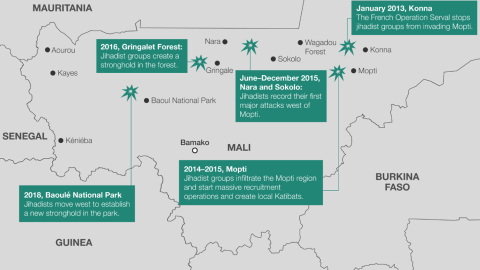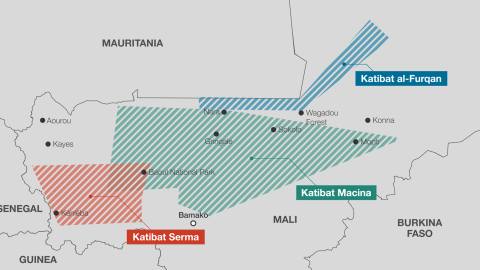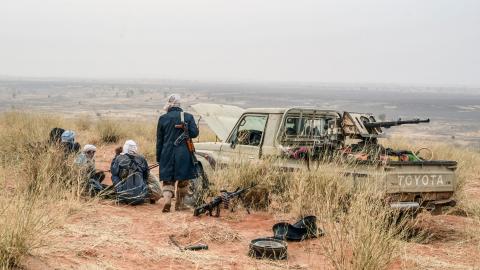Mali’s present war officially began in January 2012, when ethnic Tuareg fighters targeted several military camps in the north of the country. The international community has long understood this conflict as being centered around the question of the sovereignty of Azawad, the lands that the Tuaregs claim as their nation and that encompass Mali’s Gao, Tombouctou (Timbuktu), and Kidal region’s as well as part of the Mopti region. Since 2012, however, what began as a Malian civil war has morphed into a wider war in the Sahel region. Even as the present focus of most international analysts is on the expansion of jihadism in West Africa, rather than questions of Tuareg sovereignty, the Azawad region remains at the center of most analyses.
This is partially understandable.1 The conflict that started in 2012 has its roots in the very origins of the Malian State: Shortly after gaining independence in 1960, the country was struck by a Tuareg rebellion in 1963 that was bloodily repressed by President Modibo Keita. Many Tuaregs had to flee the country and began holding a deep resentment against the Malian state.2 This would lead to subsequent rebellions, notably in 1990, 2006, 2007, and finally 2012.3 These Tuareg armed movements for the independence of Azawad that have taken place over decades have led most analysts to see Mali’s security problems, including the present jihadist insurgencies, as being rooted in northern Mali. Even today, the northern territories are still those with the weakest presence of the Malian state and the greatest prevalence of violent confrontation. This is particularly the case of the zone des trois frontières (tri-border region), which forms the frontline between two rival jihadist groups: the group affiliated with the Islamic State, known as the Islamic State Sahel Province (ISSP), and the groups affiliated with al-Qaeda that form Jama’at Nasr al-Islam wal Muslimin (“the Support Group for Islam and Muslims”), better known by its acronym, JNIM. ISSP, which is more established in neighboring Niger, is trying to gain ground in Mali’s Menaka region, which until recently was a JNIM stronghold. In April 2023, ISSP captured the town of Tidermene.4 In response, several Azawad and Tuareg militias approached JNIM to organize a counterattack.5
Nevertheless, this disproportionate focus on the northern Malian territories is counterproductive on two levels. First, Mali’s jihadist conflicts are not local but regional. For instance, JNIM or ISSP offensives in the zone des trois frontières are waged by combatants summoned from all over West Africa. Similarly, the relative calm that existed in northern Benin during the month of July 2023 is partly explained by JNIM’s prioritization of operations at the border between Burkina Faso and Niger, as well as in Mali.6 Similarly, ISSP’s progress in Mali has been partly made through the arrival of reinforcements from Niger and Nigeria.7
Also, jihadist groups have long since reached the center of Mali and even parts of the country’s south. A series of attacks in northern Côte d'Ivoire in 2020 shed light on jihadist activity in Mali’s Sikasso region in the south,8 but analysts largely ignored western Mali and particularly its Kayes region. No publication to date reports the growing insecurity in the Kayes region, yet it looks set to serve as the entry point of insecurity into Senegal and, to a lesser extent, Mauritania.
Thus, Senegal, a pillar of stability in West Africa and a major partner in Western economic and developmental efforts, sees danger knocking at its door. Any destabilization of the country through jihadist violence would have innumerable and far-reaching consequences. Similarly, if Mauritania’s political and economic importance in West Africa is less than that of Senegal, it is nonetheless an essential regional actor from a security perspective: Mauritania has so far been a regular mediator in the Sahel’s conflicts and, due to its desert geography, it risks becoming a major rear base for jihadist groups.
The Expansion of the Jihadist Threat in Western Mali
The geography of Mali gives the Mopti region considerable importance. This region is the heart of central Mali, linking the north and south of the country. Thus, Mopti could have conceivably served as a barrier against the descent of violent extremism in the 2010s. But it did not.

The first attempt by jihadists to reach Mopti from the country’s north dates back to the capture of the town of Konna on January 10, 2013. This incident sparked the start of the French counterterrorism mission in Mali, first dubbed Operation Serval (which later morphed into the more expansive Operation Barkhane), as French forces intervened that month to successfully intercept and defeat the al-Qaeda-linked jihadists before they could reach the regional capital of Mopti. This defeat led to a change in jihadist tactics: focusing on expansion in more open rural areas and abandoning efforts to capture central cities as they had done in the north.
These strategies have proven to be extremely effective. Since late 2014, armed groups have increasingly approached the Fulani populations of Mopti and recruited this ethnic group with success. Fulani communities in Mali are organized along relatively rigid social codes: There are noble classes at the top of the social pyramid to whom Fulanis from the former slave classes or from neighboring countries, especially Burkina Faso, must bow. Jihadists offered the lower classes help in challenging this hierarchy.9 By joining the armed groups affiliated with al-Qaeda, young Fulanis of modest means could acquire social importance and wealth. Jihadist groups also invoked the legacy of the important Fulani figure Sheikh Amadou Barry, a native of Mopti, who founded the Empire of Macina via jihad in the 19th century.10
From 2015 onward, recruitment in the Mopti region increased. That same year, new jihadist recruits began to exact their social revenge by executing Fulani spiritual and traditional leaders. Perhaps paradoxically, these executions increased the number of recruits into groups affiliated with al-Qaeda in the Islamic Maghreb (AQIM). Indeed, the families of executed Fulani leaders have, in some instances, joined the jihadists, particularly the Burkina Faso-based Ansarul Islam group that is now affiliated with JNIM.11 This is explained by these families’ needs to place themselves under the protection of an armed group. Interestingly, this generated deep tensions between different factions of AQIM at the time as they were recruiting from different segments of the Fulani community—with some factions like Katibat Macina targeting lower-strata Fulani and others like Ansarul Islam targeting the traditional Fulani elites.
Solidly established in the center of the country, the jihadist groups have continued their process of local recruitment by exploiting old ethnic conflicts between the Fulani and the Dogon communities. In 2015, the Macina Liberation Front was created in the Mopti region with the blessing of the principal leaders of al-Qaeda in order to continue localization efforts. This armed group, comprised mainly of Fulani, is now better known as Katibat Macina and is a constituent faction of JNIM,12 which itself formed in 2017 to unify the various al-Qaeda-linked jihadists of the Sahel.
These recruitment strategies have enabled armed groups to firmly establish themselves in the cercles (an administrative division within Mali) of Mopti, Bandiagara and Douentza. It would seem that this move forward in the center of Mali was designed JNIM emir Iyad Ag Ghali, himself a Tuareg, who hoped that by extending forces into central Mali he would divert Malian and Western counterterrorism efforts away from the north of the country.
From a newly infiltrated center, expansion to the south of Mali commenced at the end of 2015 and was heralded by a series of notable attacks. The attack that attracted the most international attention was that against the Radisson Blu hotel in the national capital, Bamako, on November 20, 2015. On that occasion, two jihadists stormed the hotel and killed 22 people. Although the Malian capital has never been attacked since, two other attacks in 2015 signaled increasing instability in the south of the country. In June 2015, the city of Nara and its military camp were attacked and then in December 2015, the village of Sokolo in the Ségou region was also targeted. In a desire to settle locally in the south, combatants from the communes of Niono and Sokolo in Ségou settled in the Gringalet forest. This area was initially set up as a fallback area for fighters operating in the north. However, this fallback area quickly turned into a strategic outpost to organize the movement of armed groups southward.
This first attempt at local infiltration was, however, a relative failure for the armed groups. The Senegalese jihadist Souleymane Keita, leader of Ansar Dine (a group that later incorporated into JNIM),13 was arrested in the Wagadou forest by Malian services in 2016. He was one of the main leaders of jihadist forces in southern Mali. In addition, in 2017, jihadist attempts at recruitment encountered strong resistance from local populations, particularly in Dilly in Nara region, that chafed at the terrorists’ strict religious precepts.14 Faced with their inability to conquer the hearts and minds of local populations through “soft” methods, the armed groups turned to acts of predation to establish themselves. Intimidations, kidnappings, and executions began multiplying in the border areas with Mauritania, mainly in the north of Nara.
In response to this sluggish progress, JNIM’s constituent armed groups accelerated the localization process between 2018 and 2020. Hundreds of fighters were sent to western Mali with instructions to create local bases. Several emerged in the Koulikoro region, particularly in Kaloumba, Kwala, and in the Baoulé National Park. Jihadist expansion in this period even reached the westernmost region of Kayes through the locality of Kita. In this period, jihadists conducted motorcycle raids as far as 35 kilometers from the border with Senegal.
This westward expansion in Kayes and Ségou regions has not abated since 2020. On April 18, 2023, jihadists from the Ségou region ambushed a convoy near the city of Sokolo, killing the transitional government’s presidential chief of staff in a heavily publicized attack.15 Such attacks are continuing in all the regions of western Mali. The armed groups are trying to exhaust and immobilize the Malian armed forces and their allies by multiplying ambushes on soldiers as well as similar lightning attacks on customs, police, and gendarmerie posts.
The Growth of Jihadism in Western Mali: Factors of Fragility
Western Mali, comprising primarily the Kayes region, is socially and economically fragile. Historically, Kayes has for many centuries been one of the most important commercial crossroads in West Africa,15 especially for the great empires of Mali, Ghana, and Songhai. Unfortunately, with the advent of Mali's independence in 1960, the country, like many other African states at the time, based its economic development within its national capital to the exclusion of other provinces. The Kayes region, although not far from Bamako, remained relatively cut off from the capital city due to absent or defective road infrastructure.
The 2000s were nevertheless a boon for the Kayes region for two reasons. The first, surprisingly, was the civil war in neighboring Côte d'Ivoire (2002–2007). In the post-independence era, most Malian imports and exports passed through the port of Côte d'Ivoire’s capital, Abidjan,17 via a highway that links Bamako but does not pass through Kayes. However, with the start of the civil war and the division of Côte d'Ivoire into rival administrations, it became necessary to relaunch the Bamako-Dakar road that connects Mali to Senegal via Kayes. This highway quickly supplanted the one to Côte d'Ivoire and, as a result, Kayes remains to this day a commercial hub within Mali.17 In addition, from the end of the 1990s onward, gold was found in large quantities in the region.19
Despite this, ordinary citizens in Kayes quickly experienced economic disillusionment. Gold mining has generated zones of wealth in Kayes, but most residents experience economic precarity. Some villages have grown rich, but the majority have not benefited from the industry.20 Worse, the youth have abandoned traditional jobs in favor of legal or illegal gold panning, which has resulted in a shortage of manpower and skills in the agriculture and pastoralism sectors, impacting cash crop farming (primarily cotton) or subsistence agriculture (principally maize, millet, sorghum, peanuts, rice, cowpeas, and squash).21 The number of jobs created by gold mining has been far below what the population expected.22 In addition, Bamako remains the point of sale for gold, hence a large number of intermediaries in the capital take part of the profits.23 At the same time, the adverse ecological impacts of mining are significant. The region’s soil, forests, and water resources are all strongly affected by the pollution generated by gold mining, in particular illegal mining.24
Socially, the situation in the region is somewhat tense for two reasons. The first is due to the large influx of economic immigrants attracted by the gold mines. They come from all over Mali as well as from Côte d'Ivoire, Guinea, and Senegal.25 This has increased pressure on the natural resources of the region. The second reason is that, as with the hierarchies of the Fulani in central Mali, rigid social hierarchies exist in the Kayes region. Especially within the Soninké community, there are social distinctions between noble classes and slave classes.26 Slaves have periodically rebelled against this social order which disadvantages them. Thus, here too, jihadist groups are trying to recruit youth by promising them a change to the status quo.
All of these economic and social fragilities are now exploited by armed groups wishing to establish themselves locally. Groups affiliated with JNIM see in Kayes an opportunity to enrich themselves while finding new recruits. Illegal gold mining and the illegal trafficking routes between Dakar and Bamako represent a financial windfall which benefits the groups. Furthermore, the social instability resulting from economic precarity, including among youth coming from afar to work in the illegal gold mines, as well as the social classes experiencing slavery provide a source of potential future combatants. More broadly, this expansion of the jihadists into Kayes is part of an effort to disperse operations throughout Mali in order to stretch the Malian military and its allies thin.
Coordinated and Combat-Ready Katibat
No less than three different katibat (divisions of jihadist fighters), all affiliated with JNIM, are responsible for the expansion of jihadists into Western Mali.

Katibat Macina is the most established division in the area.27 Present in Nara, Koulikoro, Kayes, Nioro, and Kita, this group is responsible for the principal attacks against the Malian military in these regions. Its main bases are inside and around the Gringalet forest (Nara region), the Kongassambougou reserve (in between the Nara and Kayes regions), and Tola-Were (Nara region). This group has notably increased pressure on Western Mali by carrying out targeted attacks on the RN3 and RN1 (the main highway that links Mali and Senegal). The katiba’s fighters travel on motorcycles—or tricycles to carry their heaviest armaments—which gives them formidable mobility.
Closer to the border of Senegal operates Katibat Serma.28 This is somewhat surprising, since the unit was originally created in Gourma in Tombouctou region along the border with Burkina Faso. However, the unit has since moved west. Its first leader was arrested in December 2022 but quickly replaced, such that the arrest did not slow the progress of the katiba. The fighters’ base is located in the Baoulé forest sector of Kayes. Like Katibat Macina, Serma’s fighters organize attacks against isolated outposts of Malian security forces. Operating farther west than Katibat Macina, the Serma group is responsible for incursions along the Falémé River, which lays the groundwork for a potential move into Senegalese territory.
Finally, there is Katibat al-Furqan. This katiba, less famous than the two aforementioned ones, has nevertheless been active since the beginning of the Malian crisis.29 It is smaller and less operational than JNIM’s other combat cells. Originally from Timbuktu, it is able to operate as far as the north of the Kayes region, thereby covering the border with Mauritania. This allows it to keep an eye on the border, control an area called the Valley of the Serpent. This Valley stretches from Tombouctou to the Nara region and has been used by rebel groups throughout the history of Mali. This difficult area to access is used by JNIM to hold hostages.
Mauritania and Senegal Under Threat: The Border-Crossing Hypothesis
If Senegal has not yet suffered a major terrorist attack on its soil, the country is not completely impervious to the threat. Since the beginning of the Malian crisis, Senegalese have regularly been identified among the most radical armed groups.30 Some of them have also reached positions of responsibility, such as in the aforementioned case of Souleymane Keita, who was arrested in 2016 while commanding jihadist expansion into southern Mali.
The Senegalese state also identified the risks of jihadist expansion early on. Since 2016, Senegal has implemented a number of reforms to better protect its borders with Mali and, to a lesser extent, Mauritania, as well as to raise awareness among its population about the risks of radicalization.31
Analysts often argue that Senegal will be protected from jihadist contamination because of its singular practice of Islam, namely an Islam organized according to four major Sufi brotherhoods.32 These brotherhoods are supposedly moderate by nature and a partner through which the government can raise awareness at the local level. However, brotherhoods are not immune to radicalization and have been sometimes infiltrated by radicals.33 More so, so-called reformist Muslim groups, which are more doctrinaire and could be considered Salafi or Wahhabi, are gaining traction in the country.
In reality, Senegalese are just as vulnerable to recruitment by armed groups as any other population. Their motivations for joining an armed terrorist group may include feelings of exclusion or marginalization, as well as various political, economic, or socio-cultural reasons.34 Furthermore, an additional factor behind recruitment exists in Senegal. The country is the historical cradle of the first West African Islamic jihads and empires that began in the 17th century.35 It is possible that jihadists could exploit a sense of pride in these great conquests among local populations.
The best protection Senegal has traditionally enjoyed is simply the distance between its borders and the Sahel’s armed groups. This is no longer the case. Jihadist infiltrations, mainly from Katibat Serma, now extend as far west as the Malian cercle of Kéniéba, which lies directly on the border with Senegal. Since January 2023, armed groups have been trying to establish themselves in these areas and the reported movements of armed men on motorcycles can reach significant scales.36 This strengthening of the presence of Katibat Serma is explained by the large quantities of gold in the area, with Kéniéba a particularly notorious axis for illegal gold mining. The jihadists do not yet have the capacity to mine the gold themselves but rather seek to tax local miners. Beyond the financial benefits jihadists accrue in these regions, these areas of criminal activity are conducive to jihadist recruitment.
JNIM’s katibat probably do not yet have the capacity to strike Senegal effectively. They are still in a long phase of establishing themselves locally in the Kayes region. They still seek to increase their local recruitment in order to move around effectively. In the short term, it may be possible for JNIM to organize exploration missions into eastern Senegal as the limited presence of soldiers in Western Mali should allow them to operate around the border. Hints of their infiltration into Senegal already exist, as JNIM’s katibat engage in cattle rustling in Kayes and then hand the cattle off to contacts who sell it on the Senegalese side of the border.37
As for Mauritania, it presently enjoys the reputation of a stable Sahelian country with no jihadist presence on its territory. However, similar to Algeria, the country experienced a “Black Decade,” with major, deadly attacks on its territory between 2005 and 2011. The 1990s had been marked by instability and the rise of a radical Islamic current, after which al-Qaeda activated its cells in the country through a series of attacks in 2005. This activity escalated and culminated in an assassination attempt on Mauritanian President Mohamed Ould Abdel Aziz in February 2011, claimed by al-Qaeda. Since that attempt, however, the country has experienced a certain calm.
Mauritania credits its unique approach to combatting terrorism, which it promotes throughout the world, for reducing violence in the country since 2011.38 This method involves a mixture of increased military presence as well as deradicalization campaigns, which are conducted both through public awareness campaigns and prison education and dialogue sessions with captured jihadists. However, it is widely suspected that Mauritania’s present peace was in fact directly negotiated with al-Qaeda, as a note found in Osama bin Laden’s Abbottabad compound suggests.39 Another reason which could explain why Mauritania is not suffering from attacks is that the country is a key intermediary—even for armed groups when the need arises—to negotiate truces with Sahelian countries. With this in mind, the spectacular escape of four jihadists that were held in a high-security prison in Mauritania’s capital, Nouakchott, in February 2023 could pose a challenge to the status quo.40
The evolution of insecurity in western Mali is a considerable risk for Mauritania and requires the country to expand its border security efforts. The country has already been facing suspicious incursions from Algeria and by the Polisario Front to the north for several years.41 The destabilizations in Kayes, Nara, Koulikoro and Ségou in Mali are all the more worrying then since they suggest that armed groups are encroaching on what is called Mauritania’s “Route de l’Espoir“ (road of hope) which links the capital, Nouakchott, to the town of Néma in eastern Mauritania. This part of the border between the two countries is also particularly difficult to access, which delays military interventions and requires joint operations with Malian forces. It was in the past precisely such a joint operation, in July 2011, which made it possible to secure this territory by eliminating al-Qaeda positions located on the Malian side of the border. At the time, Mali served as a fallback area for al-Qaeda’s operations in Mauritania.42 Unfortunately, relations between the two countries are somewhat strained. When Mauritania was under attack in the 2000s, Mali was suspected of harboring the perpetrators on its territory and possibly even keeping them informed of Mauritanian troop movements. Today, ironically, the pattern is reversed, with Mali suspecting Mauritania of allowing jihadist groups to maintain rear bases on Mauritanian soil. The chances of seeing new joint operations along the border are therefore low.
One possible mitigating factor is that Katibat al-Furqan, the JNIM division that is most established near Mauritania’s border, is also the least operational of those present in western Mali. Thus, its ability to stage attacks is weak at this stage. It is nevertheless preparing the ground for potential future offensives.
Indeed, a series of attacks in May 2023 on several Malian villages located on the border between the two countries illustrate the danger to Mauritania. At least some of these recent attacks may have involved the movement of armed men from the Mauritanian side of the border: On May 15, 2023, an armed group stormed the customs post in the Malian village of Aourou in the Kayes region, killing two customs officers. The jihadists in this instance crossed from Mauritania to conduct the attack and then retreated back into Mauritania after, where they were intercepted and eliminated by the Mauritanian military. This suggests that jihadists either already have bases in Mauritania, or that they are able to use Mauritania as a transit point and shortcut to cross from one part of Mali into another.
Conclusion
The rise in insecurity in western Mali is alarming. It points to the degradation of the security situation of the entire country, the isolation of the Malian capital by armed groups, the failure of both national and international strategies to combat terrorism, and the inadequacy of development policies in West Africa. Furthermore, it is a warning sign of problems to come for Senegal as well as Mauritania.
Western Mali has its own socioeconomic particularities, whether it be the presence of social hierarchies that are contested by the lower classes, the importance of traditional slavery, or the existence of a considerable quantity of gold. However, the progression of armed jihadist groups is fueled in Western Mali by factors that have assured them a certain success whether in the center or north of Mali or even the whole of the Sahel: the feeling of exclusion, sclerotic social organizations, and economic precarity.
The presence of jihadists in the western regions of Mali indicates an imminent danger but one that still can be resolved. In this unstable context, the Malian public administration, traditional and religious local authorities, as well as large international mining companies have the opportunity and responsibility to provide solutions to the concerns of the Western Malian populations. It is notable that the Malian region that has historically produced the most migration has been the Kayes region. A deterioration of the security situation there is bound to generate significant migration flows both to neighboring countries and even further afield, such as Europe.
Senegal, for its part, is lucky to have more time to see the threat coming in advance. If jihadists prosper in western Mali, it is a safe bet that they will try to expand across the border into Senegal, which has similar populations and local dynamics as western Mali. In-depth reforms must be carried out without clinging to the fantasy of a Senegalese Islam that would be isolated and immune to any form of radicalization.
As for Mauritania, the country remains exposed to the jihadist threat. While the country seems to have succeeded in maintaining security in its territory in recent years, an expansion of jihadism in western Mali is already generating some movements of armed groups onto Mauritanian soil which we may expect to grow.
















